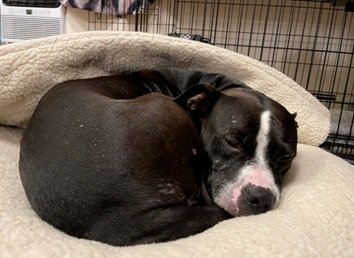Fostering a Dog with Heartworm Disease – Meet Midnight!
I fell in love with Midnight on October 5, 2021 by looking at her picture in the “Roomies with Zoomies” e-mail blast. Midnight, a black-and-white furred senior lady from the ACC, looked very similar to my previous fosters: short black fur, a white stripe down the middle of her face, white fur on her paws (aka socks), and cute little ears that I just knew would flap every time she took a step. I HAD to foster her. However, unlike my other fosters, this sweet girl was older, coming in hot at 8 years, and came with a label that fosters might shy away from: “medical case.”
Understandably, getting an opportunity to foster a dog with known medical needs can seem daunting. After getting the message that Midnight was heartworm positive, I sat for a few seconds thinking: “Am I really up for this? Will I be able to properly care for her?”
If you’ve been in this position, you are not alone, and your concerns are totally valid. But I wanted to share my experience with Midnight as someone who has grappled with the uncertainty of being able to foster a dog who needed medical care. I wanted to share because, honestly, she has been one of the easiest dogs to foster.
In the moment of uncertainty when faced with Midnight’s condition, I went ahead and did a quick Google search to learn a little bit about what heartworm in dogs looked like. Additionally, I scheduled a call with Brittany, Muddy Paws Rescue’s Foster Program Coordinator, to get more information on what Midnight’s life would look like. Here’s the quick run-down:
As the name suggests, heartworm is, in fact, worms in the heart
It’s transmitted through a mosquito bite
It is NOT contagious; a heartworm positive dog cannot pass it on to another dog, cat, or human
Staying calm is extremely important for dogs diagnosed with and undergoing treatment for heartworm, because too much movement could lead to worms causing blockages in the doggie’s vessels
Treatment is long, and includes:
A month of antibiotics
A month of rest
A series of 3 injections to kill the worms
Timely administration of Heartguard, a heartworm preventative
Love
Love
And more love
Finding out more about her care and being able to speak with Muddy Paws Rescue gave me the confidence to give Midnight a chance. “I want her,” I told my husband, and then Britt—and on October 11, 2021, she became a part of the Muddy Paws Pack.
In an effort to be transparent, I want to break down our experience with her in our home, with the hopes that you’ll see that fostering a medical case is not so different than fostering any other dog. I present to you: the good, the not so good, and the back-to-the good.
The Good
Upon arrival, Midnight gently walked up the stairs to our third floor walk up with ease. With her leash on, we let her sniff the areas of the apartment that she would have access to so as to get her used to her new environment. Soon after, she made herself comfortable on the carpet and took a nap. She didn’t have a single accident and seemed to love soft chicken treats. As we spent more time with her, we learned that, like our other fosters, Midnight loved cuddles, peanut butter, and sniffing the air when dinner was in the oven. She was housetrained, crate trained, and quickly learned “sit.” Unlike our other fosters, Midnight loved to nap and preferred soft cheese to crunchy treats. She was lower energy than the other dogs, but she still loved to sniff and make human friends on her walks.
The first few days we realized that she simply wanted to rest, and we let her do so by making her crate as comfortable as possible. For her care, we kept a list of her medications, administered twice a day with meals, sometimes setting reminders just in case. We monitored her energy levels and appetite and made sure she was adjusting okay. This part was familiar; this part was just like having our other fosters.
The Not-So-Good
One day she seemed a little different. She was more lethargic than other days, paid no attention to smelly treats in front of her nose, and would lie down to try and sleep as soon as stepping foot outside. She developed a cough that prevented her from getting a good night’s sleep and barely drank any water. I texted my foster buddy immediately and got into contact with the Muddy Paws team who quickly worked on getting her a vet appointment that same day. We grabbed a towel for her to lie on in the car, called an Uber, and made our way to the vet so that she could be seen right away.
Noticing these differences in behavior is not specific to medical cases, but for a dog with a known condition, we knew right away to look out for any potential anomalies because it could be a complication of the underlying disease. For any other foster, noticing these changes is still crucial, yet a little less expected. Thankfully, having a dog in foster care allows a rescue to provide more individualized care for every animal. For Midnight, we were able to notice these changes quickly and get her the care she needed.
The Back-To-The Good
We gave Midnight extra hugs when she came back from the vet because we missed her so much. We spoiled her with extra treats and began giving her broth in her meals to get her appetite back up. Midnight needed rest, and she quickly reclaimed her spot on the couch. The next few days we saw improvements: her appetite increased, and she started to wag her tail more. She picked up a bone for the first time and happily chewed on it near a sunny spot by the window. She followed us around the apartment but did not make a single peep when we had to crate her to step out for an hour. Her schedule was back on track, and it was such a gift each day to see her get stronger, happier, and somehow, even sweeter than before. On our walks, we could tell she wanted to chase squirrels and, though we had to stop her to make sure she didn’t get her heart rate up, we are so excited for the day when she is well enough to run after those squirrels as much as her heart desires (note to adopter: please don’t actually let her chase squirrels).
Fostering Midnight has been one of the most rewarding experiences for me this year, not only because I got to make a new fur best friend, but also because Muddy Paws was able to help a dog that may have been harder to place. What I learned was that fostering a “medical case” is not much unlike fostering any other dog. You may need to head to the vet a little more often, or wrap a pill in some deli meat, but at the end of the day, you still have a loving companion who will eventually want to steal your croissant.
If you’re curious about fostering one of these cases, need some more info or someone to talk to, please do not hesitate to reach out and ask questions. Having more information can help guide your decision, and please know that if you decide to foster, regardless of medical status, you can always reach out to the Foster Team to make sure you get the support you need!
Maria Guzman is a Muddy Paws foster and member of the Foster Team. You can follow her foster adventures on Instagram at @mguz1.







